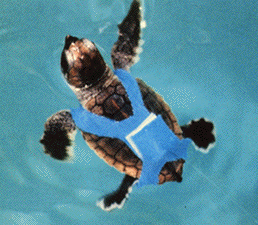
In deeper water farther from land, waves no longer provide a reliable indicator of offshore direction. Nevertheless, hatchling loggerheads tracked from a Florida beach continued on the same offshore headings even after entering areas where wave direction no longer coincided with their established courses. The ability to maintain headings seemingly independent of wave direction implies that, after they have distanced themselves from land, hatchlings use one or more alternative sources of directional information to guide their movements.
Loggerhead and leatherback hatchlings are known to orient to the Earth's magnetic field, a cue that might potentially provide sea turtles with a way to maintain a heading without relying on waves. The experiments that first demonstrated that sea turtles can detect magnetic fields involved monitoring the directions that turtles swam toward under various magnetic fields in the lab. For these tests, each hatchling was placed into a nylon-Lycra harness as shown below.

A monofilament line was connected to the harness and each turtle was tethered to an electronic tracking system in the center of a circular pool of water. Turtles could therefore swim in any direction while the tracking system monitored the direction toward which the turtle swam. This information was relayed to a computer in an adjacent room.
The pool of water was surrounded by a large coil system (represented by the red box-like structure in the diagram below). The coil consisted of numerous strands of wire. When the coil system was turned on, it reversed the direction of the magnetic field around the turtles.
In the first experiments, the orientation of two different groups of hatchling sea turtles was monitored. Half of the turtles were tested in the Earth's magnetic field. The other half were tested under identical conditions, except that the magnetic field around them was reversed by the coil system.



References:
Lohmann, K. J. 1991. Magnetic orientation by hatchling loggerhead sea turtles (Caretta caretta). Journal of Experimental Biology. 155: 37-49.
Lohmann, K. J., and C. M. F. Lohmann. 1993. A light-independent magnetic compass in the leatherback sea turtle. Biological Bulletin. 185: 149-151. [Download pdf]
last edited 04/28/2003